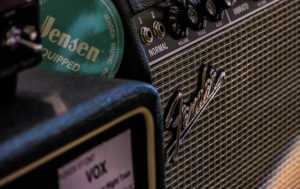- in Book Excerpt , Recording by Bobby Owsinski
- |
- 1 comments
10 Electric Guitar Recording Tips You Probably Haven’t Thought About
 There’s so much more to getting a great electric guitar sound than just placing a mic in front of an amplifier speaker. Here are 10 tips from The Recording Engineer’s Handbook 4th edition that you might have never considered, but can go a lot way in helping you capture that ultimate guitar recording.
There’s so much more to getting a great electric guitar sound than just placing a mic in front of an amplifier speaker. Here are 10 tips from The Recording Engineer’s Handbook 4th edition that you might have never considered, but can go a lot way in helping you capture that ultimate guitar recording.
1. An amplifier or speaker cabinet usually sounds better if it’s raised up off the floor so that the reflections from the floor don’t couple or cancel the direct sound from the speakers. Raise it into the air by putting it on a road case, table, or chair.
2. You can get different tones by simply moving the mic more toward the speaker’s dust cap or toward the surround (the edge of the speaker where it meets the metal basket). Different angles, different mics, and different distances from the cabinet will all alter the tonal quality.
3. The guitarist’s signal chain can be a huge help or a big hindrance. You’ll get a warmer yet aggressive guitar sound by decreasing the amount of distortion that might be coming from the player’s pedals, then turning up the amp’s volume instead to obtain the desired sustain or distortion from the amp and speaker.
4. Typically it’s best for a player new to the studio to keep the signal chain on the simple side without lots of processing happening at the amp. That being said, some effects are integral to a player’s sound.
5. So much of a guitarist’s tone comes from the fingers instead of the amp. Great players can coax great sounds from mediocre equipment, but mediocre players can’t necessarily get great sounds from great equipment.
6. On the typical 4×12 speaker cabinet (such as the standard Marshall 1960 model), the sound from the four speakers usually combines at a distance of 18 to 24 inches from the cabinet center.
7. When doubling or adding more guitars, it’s best to have a variety of instruments and amplifiers available. Two guitars (a Les Paul and a Strat, for instance) and two amplifiers (a Fender and a Marshall is the classic combination) combined with different pickup settings will allow a multitude of guitar tracks to more effectively live in the mix together.
8. In an odd paradox, smaller amps and speakers tend to sound bigger than large amps/speakers when recording.
9. To find the sweet spot on a speaker, put on headphones and listen to the amplifier hiss as you move the mic around on the speaker. You can also insert pink noise into the input if the sound of the amp at idle isn’t loud enough. If you can remember what the hiss sounded like when you had a good guitar sound, then that’s a good place to start.
10. Ask the guitar player to turn the tone control on his guitars back a touch. This warms things up and makes it sound a little bigger, especially if you’re layering three or four guitars on top of one another.
You can read more from The Recording Engineer’s Handbook and my other books on the excerpt section of bobbyowsinski.com.

